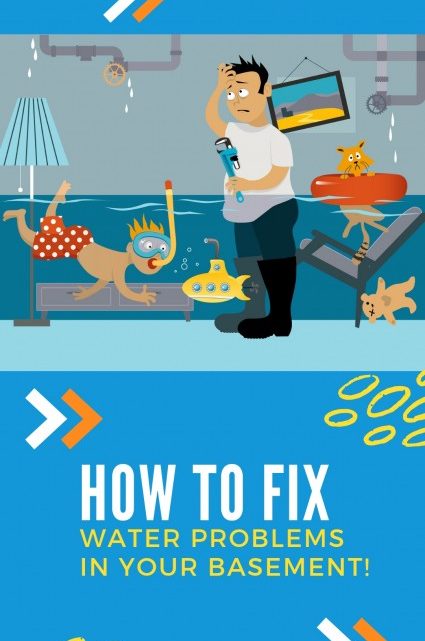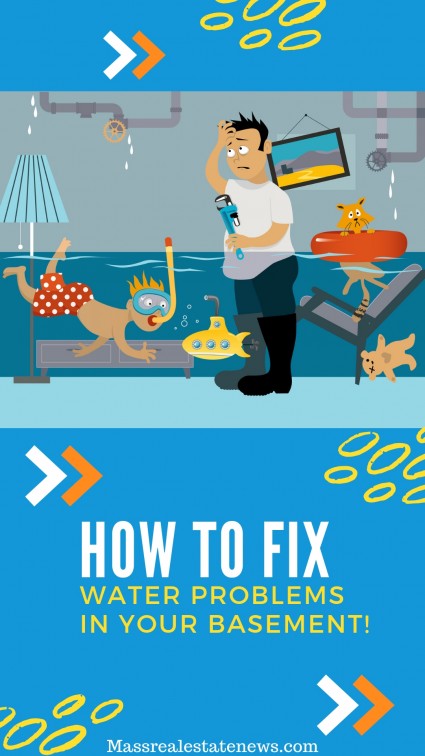How to Prevent Basement Water Problems?
How do you stop your basement from having water problems? Homeowners across New England are locked in a never-ending battle with moisture in their basements and crawl spaces.
The lingering smell of mold and mildew relegates many basements to use as tool storage or a guest room of last resort, the place to stick that annoying aunt when you can’t say no. Basements shouldn’t feel like caves. Even minor moisture problems can hurt a home’s resale value immensely.
Quite often, basement water issues can occur in areas where flood insurance is required. Your basement doesn’t have to flood to experience water damage though. Left untreated, even minor moisture problems will permanently damage vital parts of a home. Cracked foundations and rotting floor joists can turn an otherwise desirable home into a money pit, and a professional home appraiser is going to take thousands off the value of your home if he catches basement water damage.
Besides the cost of repair, a damp and moldy basement is downright undesirable to many potential homebuyers who want a move-in ready home, not a fixer-upper.
Don’t worry, though! This handy guide will layout five solutions used by professional waterproofing contractors to prevent that big repair bill.
 Five Solutions for a Damp Basement
Five Solutions for a Damp Basement
A home’s basement can take water for a variety of reasons. The most common reasons for damp or flooded basements are a high water table, a drainage problem, or a damaged foundation. Each basement waterproofing solution has its advantages and disadvantages. There are, in fact, many ways to solve basement water problems.
1. Install a Sump Pump
Sump pumps are water pumps attached to a concealed drain or basis in your basement. The basis collects any excess water that finds its way past your foundation, and when it begins to fill, the pump kicks on, draining that excess water to your home’s primary drainage system.
Sump pumps are the go-to solution if you live in an area with a high water table. Water flows in very predictable ways. If the bottom of your foundation is deeper than the local water table after a rainstorm, you will definitely take water. There’s no practical way of stopping the natural water table with barriers or paints. It would be the home-waterproofing equivalent of Caligula’s war against the ocean.
What you can do, however, is redirect the water that gets through your foundation. That’s where a sump pump comes in. Without a sump-pump, a basement built atop a high water-table probably looks like it’s trying to compete with Hurricane Harbor every time a storm hits.
Once a sump pump is installed correctly, that all changes. First, water gets drained into the pumps catch basin instead of flooding your home. Then, once enough builds up, the pump switches on and carries all that water to the sewer system or street drains. See everything you need to know about installing a sump pump.
2. Install a French Drain
Want a fun trivia fact? French drains are actually from Massachusetts! Henry Flagg French was a lawyer, inventor, and president of the Massachusetts Agricultural College, which survives today as the University of Massachusetts Amherst (UMass).
He perfected a cheap and effective way to drain farm fields using gravel and clay pipes. While plastic has replaced clay, the system French described is still in broad use to control drainage around homes and in farm fields, over a hundred and fifty years later.
Outdoor french drains are created by digging a ditch around your foundation. Perforated pipes are laid in around your foundation, graded to slope away from your house. These pipes are then put under several feet of gravel. Depending on your soil, contractors might also bury a layer of landscape fabric to keep silt or fine sand from clogging your drain.
The drain acts as a man-made aquifer. Water follows the path of least resistance. A gravel-lined ditch is a lot more water-permeable than a concrete block wall. When it rains, water will still drain towards your house (the root of most moisture problems) but will collect in the drain instead of seeping through your foundation.
In some cases, especially in areas with hard clay soil or fine silt that would quickly clog a traditional french drain, installers will instead opt for interior installation. The pipe-and-gravel design remains the same, but instead of digging around your foundation, the installers jackhammer a channel around the edge of your basement’s floor slap, install the drain there, and then cover the canal with cement, leaving a narrow gap for water to enter the drain.
If you have a sump pump already, some installers will grade the system to drain into that basin, to more effectively remove water.
3. Install a Vapor Barrier
A missing or poorly-installed vapor barrier is the leading cause of water damage in finished basements. Like other parts of your home, a finished basement requires insulation between the exterior walls ( in this case poured concrete or cinder-blocks) and your interior drywall. If there is no insulation, or if the insulation is not adequately protected, moisture will eventually get trapped between the drywall and the cinder-block. This will cause mold and mildew to grow behind your wall, and ultimately, destroy your drywall and rot the framing.
There are two ways to avoid this when finishing a basement. One way is to wrap the room in 3mil or thicker vapor barrier before installing fiberglass insulation. Fiberglass makes for excellent, cheap insulation, but it’s like the nightmare child of a cotton ball and a kitchen sponge. It absorbs water easily and takes forever to dry out. Buy putting a vapor barrier between the cinder-block and the insulation; you can be sure it won’t get damaged and waterlogged from normal humidity. Flooding or a cracked wall could still cause problems and damage the insulation.
The other option, if you’re willing to spend a little more on insulation, is the use of sprayed or sheet foam insulation without a vapor barrier. Extruded polystyrene insulation (pink or blue foam sheets) is a closed-cell foam, and so is inherently waterproof. The same goes for most brands of spray insulation. If you choose to insulate with foam, the insulation effectively becomes the vapor barrier.
4. Apply Waterproofing Paint
Many hardware stores have started to sell all-in-one DIY products to fix moist basements. These are roll-on coatings in a paint can that claim to totally waterproof your basement for a fraction of the cost of professional waterproofing.
If you trust the product marketing, these coatings sound like magic. If you talk to a pro contractor about these products, he’ll laugh them off as snake-oil, just some grey enamel paint repackaged as a miracle solution.
The truth is somewhere in between. Waterproofing paint creates an impermeable barrier on the surface of your concrete walls. If you’ve been experiencing water stains, mold, or efflorescence on your walls, these paints will temporarily hide that. You still have a drainage problem, and after a year or two, the paint will start to peel and crack from the moisture behind it.
Waterproof basement paint is a temporary fix, not a long-term solution. However, if you will soon be selling your home, or simply don’t have the cash to afford a french drain or a new vapor barrier, any of the all-in-one waterproofing paints can be the perfect product to fight moisture, and prevent even more expensive damage. It’s the home-repair equivalent of Tylenol–it won’t permanently fix what’s hurting, but it will get you through until you can see a professional.
5. Regrade Around Your Home’s Foundation
Most waterproofing solutions involve redirecting water away from your foundation, and this is no different. Water always runs down-hill. In an ideal situation, your home would be situated like a pitcher’s mound in the center of your lot, with the ground gently sloping away, and the lawn graded as a mild slope from your front porch to the street.
Unfortunately, home lots are rarely perfect. Some homes are at the base of a hill. Others are on extremely flat ground, where the original home builders never bothered to back-fill with soil and create a grade. Many older homes were built on well-graded sites, but after a century of erosion and settlement now sit level with the rest of their lot.
Changing a house’s grade requires several tons of soil and is outside the scope of a DIY project unless your friends can lend you a dump truck and a backhoe. That said, contractors could regrade most houses in a day or two. Once a proper grade is established, water will naturally flow away from your home instead of collecting in your basement.
Do Not Wait!
Do not wait for disaster to strike! Remember the five P’s – prior preparation prevents poor performance. Get ahead of water damage and devise a plan. Hopefully, the information provided has been a big help in providing assistance for preventing water issues in your basement.
Other Real Estate Articles Worth Reading
- Repairs to make prior to selling your house – see four excellent home improvements you should consider making before selling your home. These improvements will go a long way towards helping your property sell, as well as providing a solid return on investment.
- Moving to a larger home – learn some of the most important considerations when deciding to move up to a larger property.
- Advice when purchasing your first home – great tips for first-time home buyers. See what it takes to make sound decisions when buying your first home, as well as avoiding some of the more common mistakes.
Use these additional researched articles to make the best decisions possible when buying or selling a home.
 About the author: The above article on preventing basement water damage was written by Jennifer Bell. Jennifer is a freelance writer, blogger, dog-enthusiast and avid beach-goer operating out of Southern New Jersey.
About the author: The above article on preventing basement water damage was written by Jennifer Bell. Jennifer is a freelance writer, blogger, dog-enthusiast and avid beach-goer operating out of Southern New Jersey.











No Comment